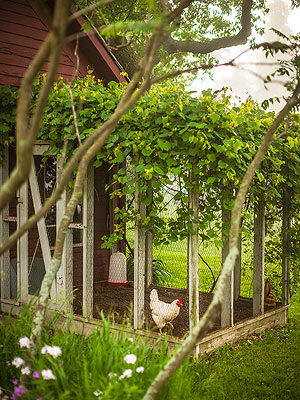
Chicken Coop Plan Basics

There isn’t a single perfect chicken coop design, but safe chicken coops share similar designs. Here are some considerations, whether you are building or buying a coop:
continue reading below
Size
Allow 2-4 square feet of floor space per hen. Plan for the eventual number of chickens you intend to have, because it’s always easier to start with a large chicken coop than it is to add onto a small chicken coop later.
Elevation
Raised coops prevent predators from digging up through the floor, prevent a wooden floor from rotting, and allow the chickens space underneath to escape from sun and rain. Decide if you are going to elevate your coop on bricks, cement blocks, or a wooden framework — and how high off the ground it will be.
Learn more basics about starting a chicken coop.
Flooring
If your coop is not raised, your flooring might be dirt (easy for predators to dig under to gain access), cement (deters predators and rot), or wood. Raised coops with plywood covered with vinyl linoleum makes an inexpensive, durable flooring that is easy to clean.
Bedding
Straw or pine shavings make excellent bedding. Hay should not be used as it molds and mildews easily, and sand should be avoided because it doesn’t insulate from the cold and can harbor pathogens.
Ventilation
Adequate ventilation is important to allow fresh air to circulate and moisture to escape from your coop. All windows and vents should be covered with ½-inch hardware cloth to keep predators out.
Nesting Boxes
The nesting boxes are where your chickens will lay their eggs. Plan for one box per 3-4 chickens. Each box should be approximately 12 inches square. Boxes can be at floor level or slightly raised with a ladder or ramp to allow the chickens access.
Roosts
The roosts are where your chickens will sleep. Roosts can be wooden boards or branches. Plastic should not be used because it is slippery; metal should be avoided because it gets too cold in the winter. Allow 8 inches of space per hen and be sure to position your roosts above the nesting boxes (otherwise your chickens will be tempted to sleep in the boxes and soil the box bedding).
Predator-Proofing
The door to your coop should be outfitted with a predator-proof lock. Raccoons can undo latches and slide deadbolts, so a locking eye hook is safer. Nesting box lids need a secure latch as well.
If you keep these various features in mind when you are coop shopping, you will end up with a suitable coop for your flock.
The following chicken coop plans incorporate these features into a compact 4×6 coop, perfect for six to eight hens, which includes three nesting boxes and 12 feet of roosting bar space.
download standard chicken coop plans
download urban chicken coop plans
Inspiring Chicken Coop Ideas
Inspiring Chicken Coop Ideas
SOURCE:http://www.bhg.com/gardening/landscaping-projects/garden-structures/chicken-coop-plans/